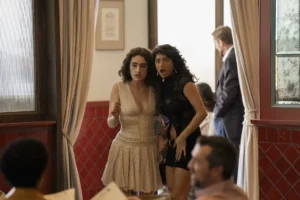Summary
Anna Kendrick’s debut shows promise as it tackles a prominent serial killer story but ultimately fails to deliver.
The first unique selling point of Woman of the Hour is that it is Anna Kendrick’s directorial debut. The A Simple Favor star has decided to extend her art behind the camera and has kicked off that with a heavy film. The second unique selling point is that the drama thriller is based on the true crime case of serial killer Rodney Alcala.
There is not a third selling point as most of the Woman of the Hour is a generic true crime feature we’ve become accustomed to. However, I will say that the movie’s last twenty minutes provide promise for Anna Kendrick’s directorial future as she provides a chilling account of the serial killer’s history and, ultimately, his downfall.
If you are unfamiliar with Rodney Alcala, then he was an American serial killer and sex offender in the 1970s. His victims were women and young girls, and the estimated number of victims ranges in the 130s. Rodney Alcala was incarcerated and died in prison for the murder of 7 people.
Serial killer true crime stories are hardly fables in the mainstream nowadays, but Anna Kendrick and her writer, Ian McDonald, take a different angle. They water down the profiling of Rodney Alcala and strengthen the stories of the women impacted, which is a valuable angle to take.
Anna Kendrick plays Sheryl (presumably based on the real-life person Cheryl Bradshaw), an aspiring actress in LA who is frustrated with the lack of opportunities. Cheryl decides to follow her agent’s strategy and participates in the TV dating show “The Dating Game,” which ran on the ABC Network between 1973 and 1999 (it was reborn briefly in 2021 as “The Celebrity Dating Game” but was quickly canceled in 2022). The purpose of her appearance was to gain exposure for her career (a widely used strategy used with Reality TV today).
As a dating participant, Sheryl encounters serial killer Rodney, one of the three men trying to secure a date. The movie splices Sheryl’s encounter on the dating show alongside the experiences of other women who encountered Rodney.
There’s a strong theme throughout the movie that dabbles in the treatment of women by men that is relevant to the present day, but the film brings a 70s outlook where misogyny was more rife and on the surface. There was no need for micro-aggressions back in the 70s – the imbalance dynamic between men and women was baked into American culture.
Woman of the Hour strongly upholds the feminist angle, sometimes to the detriment of storytelling. This is mainly because the messaging is obvious and hardly nuanced. The script almost spells it out to the audience, which is not the best approach to any film.
The strongest and most salient message in the feature is that there are men who are not committing crimes against women but are failing women by simply not speaking out or changing attitudes. This point was well made.
However, Woman of the Hour is quite a generic piece of filmmaking. It confirms that Anna Kendrick can direct, but her tools need sharpening. It does not help that we’ve become accustomed to true crime, almost desensitized to it due to our addiction to be exposed to gore and other sensationalist subjects, which means, unfortunately, filmmakers are required to bring something of more depth to surprise their audiences.
It does not help that I’m likely putting Anna Kendrick on a higher pedestal because this is her debut, and I expect more. I will say this: the cast’s performances are brilliant, even the supporting actors who barely get screen time. If Anna can continue bringing these performances under her leadership in the future, then we are in for a treat.
As I alluded to at the start of the review, the last twenty minutes are the most powerful segment of the film, which pays off the first two generic acts. While this crime drama is not particularly special, the potential at the end is shown.
Read More: Woman of the Hour Ending Explained



